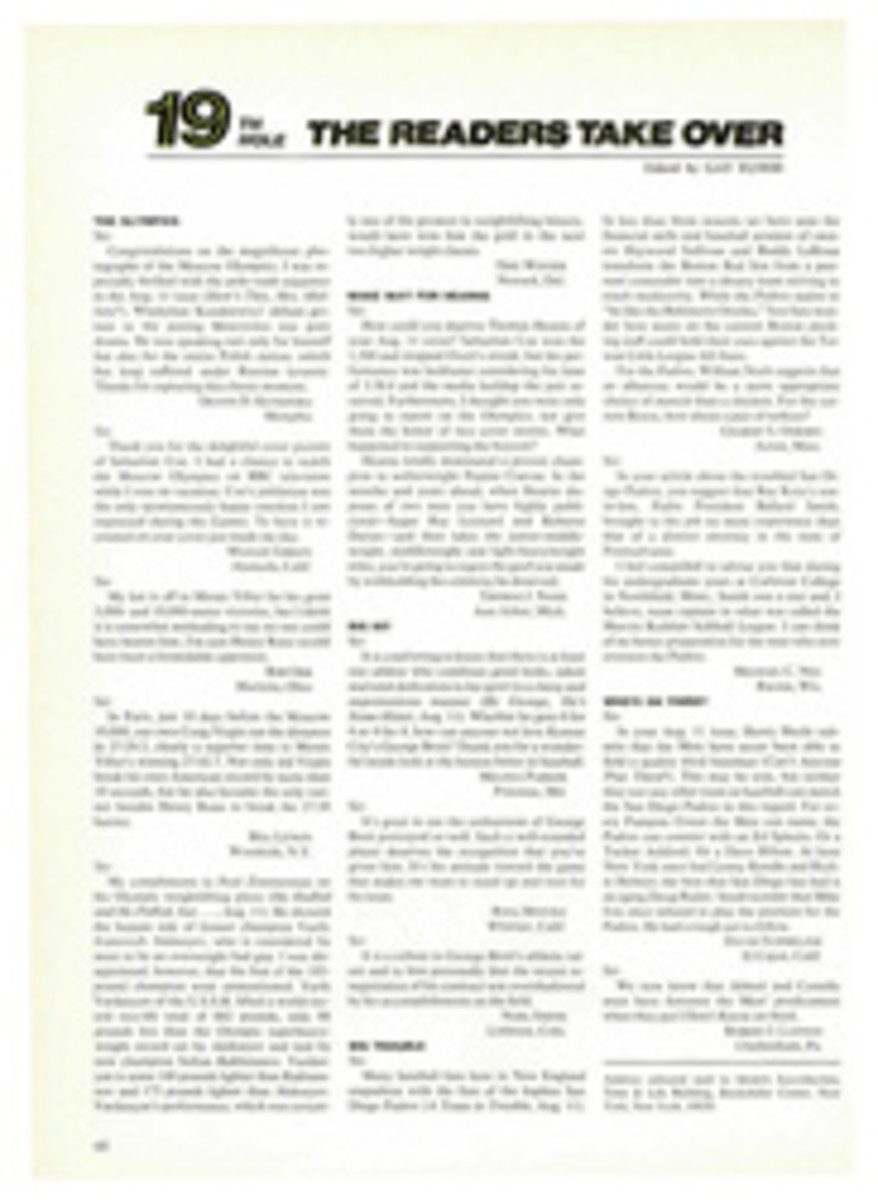
BOARD AND VROOM IN WINDSURFER HEAVEN
The first man to put a sail on a surfboard deserves a place in some future hall of fame alongside the guy who tied barrel staves to his feet one winter and ushered in the golden age of the autographed leg cast. Both were on to something, but they didn't go far enough. One didn't invent the ski bunny and the quick-release binding. The other didn't know about the universal joint. Hoyle Schweitzer was acquainted with this bit of hardware, and in 1967 he used it to fasten a mast to a surfboard, thus inventing a wonderful piece of equipment called the Windsurfer and forging a minor miracle. Schweitzer had transformed sailing into a tingling spectator sport, and if you don't believe it, you weren't at the 1980 American Windsurfer Championships last week at Falmouth, Mass. on the west side of Cape Cod's Buzzard's Bay.
The sport itself is officially called board sailing (the Windsurfer, the most popular American board, is a trade name) and more than 500,000 sailboards have been sold around the world. It is also the only sailing sport that offers competition in freestyle and slalom racing in addition to round-the-buoys course racing and a nasty ordeal known as long-distance racing. A Windsurfer sailboard is only 12 feet long, with a 59 square-foot sail and a small daggerboard, but it can turn on a sand dollar and perform spectacular feats. The sounds heard above the keening Cape Cod winds last week were cheers from the beach-bound spectators. Indeed, whoever wrote the script—and it seemed that someone must have—may have overdone things at the outset by ordering up too much wind. It gusted offshore to 35 knots on the first of the five days of competition. Only three of the four men's weight classes—officials had to cancel the medium-weight event because of the wind—could complete a course race, and no woman had the muscle to make it past the first windward leg.
Then for two days the wind moderated. Preliminaries were held for slalom racing and the freestyle event, the former a test of tacking, jibing and general boatmanship, the latter a display of virtuoso footwork, balance and waterborne acrobatics. There were pirouettes, forward and backward hair wettings (a/k/a nose dips and head dips) on the flighty boards, rail rides, with the boards slicing along on their edges, and other equally improbable maneuvers.
The week's particular hero would be the so-called pentathlon winner, the sailor with the best total score after all four events, course racing counting double. All the men's classes were eligible, as well as the one for women, and at the end of three days five competitors were nearly dead even: 26-year-old Nancy Johnson of Newport; brothers Alex and Greg Aguera, 19 and 17, of Clearwater, Fla.; Cort Larned, 25, of Fort Lauderdale; and Anders Foyen, 22, of Norway.
Midway through the fourth day, with the wind freshening to 15 knots, the slalom finals began. They were unisex, and one-on-one races, over a six-buoy course. The first of the leaders to falter was the 118-pound Johnson, who kept falling over and lost her initial race in the stiff breeze to 180-pound Mark Robinson of Clearwater Beach, Fla. He had the strength to carve far tighter turns. Next to drop a race was Alex Aguera, but in the loser's bracket he hung on to win four straight. Finally it was brother against brother, Greg against Alex, for the slalom title. The two Agueras tacked simultaneously at the first buoy, but at the weather mark Alex fell from his board and was slow to get back on. Then he fell again. His father, Joe, the Florida distributor for Hoyle Schweitzer's Windsurfing International, which manufactures the boards, said on the beach, "It's Alex' seventh slalom race today, and he's dog tired."
On lap two a wave caught Greg and threw him farther down the course than he had anticipated. His boom, barely missing Alex' head, brushed his brother's mast, and Greg shouted over the roar of the wind and waves, "I'm sorry," as he swept by. Alex fell, and Greg sailed smoothly on to victory, then jumped through his wishbone boom just beyond the finish line and landed in the water. Alex leaped off his board, grabbed Greg's head and angrily shoved it underwater.
Ashore, Greg was asked if he knew he had knocked his brother overboard. "No," he said, "the only time I look at the competition is at the end of a race."
"Did it feel funny racing against Alex?" he was asked.
"Funny? It felt good," said Greg, a mere 5'5" and 134 pounds to his brother's 5'9", 154. "Alex has always been a little better and bigger than me."
Next month Greg will enter St. Petersburg Junior College, meanwhile teaching board sailing and selling Windsurfers for his dad. Dad said his biggest problem is getting enough Windsurfers to meet the demand. "We're just scratching the surface in this country," he said. "There are 20 times as many in Europe."
The group on the beach and in the parking lot wasn't your typical yachting crowd. Many drove vans, and the music they played was from the Rocky Horror Picture Show, the vans sported bumper stickers that read: BORED SAILORS GO BOARD SAILING. One favorite topic of conversation was the Windsurfer prototype that averaged 28.3 mph over a 500-meter course last month off Maui, making it the second-fastest sailboat in history. (The fastest, a catamaran, went 38.9 mph.) Another was the recent decision to include board sailing in the 1984 Olympics.
On the last day of competition the stiff beach grass lay flattened on the dunes. The wind gusted onshore to 22 knots, sandblasting the gathering crowd. The conditions were terrible for the freestyle competition, in which balance and control are crucial; bigger, stronger sailors would be the beneficiaries. Half the sailors out practicing in the bay were swimming, and when competition began, many were as much in the water as out of it. Matt Schweitzer, Hoyle's 20-year-old son, fell twice but wound up his freestyle routine with a double pirouette, which is spectacularly difficult, particularly under the circumstances. Greg Aguera did a head dip, then reversed his sail, rode his rail for three feet—and went into the drink. In spite of that spill, he finished second to Schweitzer.
Unfortunately, in the slalom event the day before, Schweitzer had forgotten the course, got lost and finished way back in the pack. It seemed that would put him out of the running for the pentathlon title, but he was said to be a fine long-distance racer. And with the wind getting stronger, anything could happen.
When officials confirmed that the event would take place despite the heavy weather, one spectator gasped, "I can't believe it. No one can live out there." By now the wind was up to 24 knots. Dick Lamb, president of the International Windsurfer Class Association, plotted a course consisting of two elongated runs, at right angles to each other, one 3½ miles around, the other 2½ miles. Each would be sailed twice for a total distance of approximately 12 miles. Not only would the race be difficult in that wind, but also just getting through the surf to the course was a problem. A rapt audience waited, huddled under blankets, eyes slitted against the wind and the blasting sand. Nancy Johnson sat among the spectators. "Not racing?" she was asked. Replied Nancy, "Do you think I'm a masochist?"
Fifteen minutes into the race, the committee boat radioed to shore, "We've got four-to-six-foot waves out here." That's a lot of water for boards that weigh only 60 pounds with sails and masts attached. Approximately one-third of the way through the race the leader was Ken Winner, the 1978 pentathlon champion. Larned was second, Schweitzer third, Alex Aguera sixth and Greg Aguera ninth. Greg seemed to be tiring rapidly. It was hard to say whether he was sailing or being sailed. "He's shot," his father said. "It's a race for the big, strong guys, but he won't give up."
A corridor was cleared on the beach; the finishers would have to land and run up the sand to a finish line, which seemed a fiendish chore after what they had been through. But all made it—Schweitzer first, Larned second, Alex Aguera fifth and Greg Aguera seventh.
Schweitzer had won three events, the course race in the light-heavyweight class, the long-distance race and the freestyle. The slalom had hurt him, but he still hoped for victory in the pentathlon, as did Larned and the Agueras. Not until the awards banquet that evening was the scoring completed. Dick Lamb held up a silver bowl and gestured to the space for the name of the 1980 all-around champion—Greg Aguera. Larned finished second, Alex Aguera third and Schweitzer fourth. Said Greg, "I never expected to beat all those guys in this much wind, but it sure feels good." Especially when one of those guys is your big brother, eh, Greg?
PHOTO
PAUL KENNEDY
Like a bevy of waterborne butterflies, the colorful fleet of 250 Windsurfers skims smartly across the bay shortly after the start of a round-the-buoys race.
PHOTO
PAUL KENNEDY
Ken Winner jumps for joy with his Windsurfer Rocket, a sailboard equipped with foot straps.
PHOTO
PAUL KENNEDY
The women's champion, Nancy Johnson, lowers the boom during the freestyle preliminary event.
PHOTO
PAUL KENNEDY
Into the air goes Platt Johnson, Nancy's husband, demonstrating the surfing aspect of the sport.
PHOTO
PAUL KENNEDY
When the wind died, the competitors kept the spectators on the beach entertained with a sedan-board act that might have done Liz Taylor proud.
PHOTO
PAUL KENNEDY
Greg Aguera: second in freestyle, tops overall.

